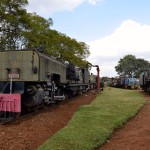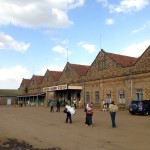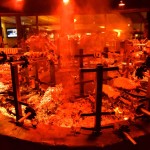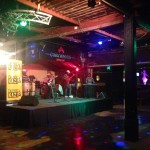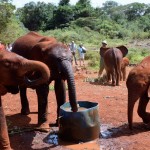Arriving in Kenya and taking a tour of the top sights of Nairobi on the trip The Great Eastern Summer.
After climbing Kilimanjaro and doing the safari circuit, Lake Manyara, Serengeti, and Ngorongoro we were headed to Kenya.
From Arusha they had an international bus directly to the capital. It left early in the morning but the company fortunately picked people up from their respective hotels in a minivan.
We were dropped off at the private bus station and boarded our bus. Hawkers begged at our windows to buy their cloths and crafts. We waited until almost every seat in the bus filled up, before we departed.
We hit some Arusha traffic before reaching the well paved roads northward. The ride was comfortable and a couple of hours later we were at the border.
First we lined up and got our exit stamps at the Tanzania border control office. One dark and dirty room had a sign that read “vaccinations”. I’m glad we got our mandatory Yellow Fever vaccinations aboard instead of doing it here.
Then we walked across these unfinished border buildings to the Kenya side. Strangely, the area was surrounded by slums and piles of garbage. Not a very pleasant place to take a stroll.
After a long line, we got our entry stamp for Kenya. Country 75 complete!
Maasai ladies stood around the bus to try to sell their handmade jewelry and handicrafts.
Continuing the trip, we had a smooth ride until we arrived in Nairobi. Immediately the traffic was terrible with trucks and motorbikes blocking the 3 lane highway. The surroundings were pretty shady.
Arriving downtown, we grabbed some Kenyan shillings and a burger from a local fast-food chain, Steers, then took a twenty minute walk to our first sight.
The National Museum dates back to 1910 when colonialists needed a place to store and display their collections, though the current museum was legally established in 2006.
The exhibits were actually surprisingly good. They had a section with a huge collection of stuffed birds, a collection of early human skulls and bones, and a room of stuffed animals of Kenya. Then there was the history of Kenya through colonialism.
There was also an art expo upstairs done by local artists with a couple of interesting pieces.
Outside we walked to the snake park which was like a small zoo focused on snakes. They also had some fish, tortoises, and gators.
After that we bags from the coatcheck and bargained with a taxi to take us to our hotel. For some reason, his wife joined us.
The ride was pretty straightforward and left the shady downtown to an upscale diplomatic area. We checked into our hotel, Tribe, and relaxed.
A friend of a friend, Grace, was holding a party at The Village Market, a commercial center right next to the hotel which was convenient.
We walked over, went through the metal detectors of the mall security and found the bar. Grace met us at the entrance and explained that the event was an Internations networking event.
We had a couple of drinks and met quite a few interesting people in very varied fields. A Rwandan banker shared with us his pride for his country. A security firm manager showed us pictures on his phone of assailants that were gunned down by police minutes after it happened. We even met some managers from the Sarova Stanley Hotel, where we would stay after the safari. As most were there to network, many were puzzled as to why tourists would be at the event.
After the long day of traveling, we were quite exhausted, so we left the event to get some sleep.
The next day after an amazing breakfast, we planned out our trip to the Mara. Then walked over to The Village Market to meet Grace and her friends for lunch. We chatted over German food and beers before we started a tour of the city.
Grace introduced us to a friendly driver, Evans, who took us on a tour through Nairobi.
We drove by Westgate shopping mall, where an al-Shabaab terrorist attack took place less than a year ago, and saw the bullet holes on the building. 67 people were killed from the attack, possibly including some of the terrorists and three floors of the mall collapsed. The mall of course was closed and our picture taking drew the attention of the security guard, so we drove off.
Apparently they never caught the people who did it. The driver said they had people in custody but they were scapegoats. He also told us about an ex-policeman hero that held the terrorists at bay with a handgun and saved many lives.
Then we went to a park which offered a viewpoint over town. This is the location where the president would give speeches to the masses.
We continued downtown but eventually parked in the lot of an office building because of some ridiculous traffic. As we walked among the crowds we saw a group of drivers try to pull down a fence in the road.
From the pedestrian overpass, we saw the traffic was caused by a bus perpendicular to the road. Our driver spoke to a guy who explained what happened.
It seems that police officers often take brides from the ticket collectors of the watutus (local buses) so that they can avoid a fine. In this case the ticket collector refused to pay a bribe and as the bus was driving off, the police officer pulled the man out of the vehicle and he fell under the bus and was killed. The driver and passengers of the bus blocked the road in protest.
We continued to the Nairobi Railway Museum which was a pleasant surprise. They had interesting train memorabilia, including an engine chair that was fixed to the front of the train that Teddy Roosevelt sat on to shoot animals during the train ride.
The museum had an outdoor area holding several old trains in original condition that visitors could explore.
On our way back, we walked right by the bus where crowds had gathered watching a couple of shirtless individuals yelling from the top of the bus. Riot police were deployed in the street.
At that street corner was the August 7th Memorial Park where the previous US embassy use to be located. It was blown up by an al-Qaeda terrorist attack in 1998 where 213 people were killed, though only 12 were the targeted Americans. The other part of the attack took place at the embassy in Dar es Salaam where 11 people were killed. Today the site is a memorial park.
Possibly due to the impending riot, they weren’t letting people in.
We walked downtown and went through a few shops and a tourist mall were I got my tourist shirt.
Our guide showed us some important buildings including Nairobi City Hall, Kenyatta International Conference Centre, the Parliament, and Nation Center and then led us back to the car. As the sun set, we watched huge marabou storks settle into their nests atop of electricity poles or shift through garbage on the streets.
Evans drove us to Carnivore, the famous restaurant known for its exotic meats. A bit of a distance away from the city, we arrived and ordered beef, lamb, ostrich and crocodile accompanied with some local beer. The meats were roasted over a fire and were quite succulent.
After dinner Evans took us back to the hotel, just as the food coma was setting in.
The next day, we set out early to visit some sights before our flight.
Evans picked us up and took us by the massive US embassy and UN compound. Then we passed by downtown to drop off our luggage at the Stanley.
We then headed to Karen, a residential area where the descendants of British colonialists live. They are known as the white cowboys.
Our first stop was the Giraffe Center near the Nairobi National Park. This small park is known for its family friendly event of giraffe feeding. After paying the entrance, you ascend a platform where friendly staff offer handfuls of giraffe kibbles. Then you can stick your hand out and watch as the long purple tongue of the giraffe slop up the dry food. If you are daring enough, you can also “kiss” a giraffe by holding a kibble between your lips!
There were also warthogs at the feet of the giraffes and another enclosure for large tortoises.
A short drive away is The David Sheldrick Wildlife Trust which includes an elephant orphanage. Even though we arrived a half an hour early, a line was already starting to form.
When they opened, we walked in with the huge crowd got our tickets and lined up around the fence where baby elephants were being fed with milk bottles. The park was soon packed and a man started introducing the park and the wildlife trust. Most of the elephants are orphans whose mothers are victims of poachers. After they are adults, they are returned to the wild.
Another group of older elephants joined the party. Then after their feeding, they wander around playing in the water and dirt. Sometimes the elephants walk along the fence so that the visitors can pet them when they walk by. I was even able to give an elephant a handshake! He was sticking it at me to smell and I just squeezed the end of the little trunk. So cute!
I had to be careful that he didn’t stick my hand into his mouth as you can lose fingers to elephant bites as the posted signs warned.
You can also adopt one of these critters. See their site here for details.
After that visit, we were off to Wilson Airport for our flight to Maasai Mara!























